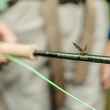The next time you're wading your favorite freestone stream in the warmth of a summer day, and all of the sudden notice a rush of colder water around your legs and ankles, take note. Chances are, you've stumbled on a spring seep and that seep can mark an area where fish will congregate. In summer, that seep and the relatively cooler water it is contributing to the flows of the stream can offer a respite for trout when water temperatures rise. In winter, these seeps can be true fish magnets as the spring-contributed water will be much warmer (sometimes more than 20 degrees) warmer than the icy-cold flows of the potentially snowy banked river you've ventured onto.
Most fishermen are aware of the fact that full-on spring creeks and tailwaters can be great winter fisheries, due to the fact that their waters flow much warmer than their freestone cousins, and as a result trout are more actively feeding within them. Spring seeps create the same environments for otherwise sluggish winter trout, except they are micro-environments, so where trout are spread out throughout the full breadth of spring creeks and tailwaters, spring seep influenced areas in freestone streams are relatively small -- leading to a high concentration of trout in a small area.
Thankfully, finding spring seeps in winter doesn't have to mean endless hours of GPS reconnaissance seeking out thermal differences during the summer months, as wintertime scouting can offer up several clues to finding these trout hot spots.
Look at the Banks
Snow and ice prevail on many a riverbank in the winter months and while they can make trudging along those banks a bit more work and a bit more dangerous, they can help offer up clues to where spring seeps lie. Areas along the streambank where a spring is influencing the streamflows can often have reduced snow levels and reduced ice concentrations. How significant these differences are depends on the strength of the spring influence. Sometimes they can be subtle, such as little more than a slight depression in snow levels along the bank, or they can be glaring, marked by brown grass showing through virtually snow and ice free banks.
Look at the Riverbed
The warmer water temperatures that spring seeps create in winter rivers can often allow green vegetation that has long departed the rest of the river's stream bed to persist throughout the year. With the right sun angle, these areas can often stand out prominently -- if you're looking.
Look for a Trickle
Spring seeps can also occur as small tributaries where the spring seeps as surface water adjacent to the stream and trickles in as a small feeder creek. This may resemble a tiny tributary or may literally be visible as little more than a dribble with paltry flows. Even those paltry flows shouldn't be ignored, however, as they can often be deceiving and don't offer evidence as to what's going on beneath the ground.
Look for Fish
As noted, spring seeps in winter freestone streams are fish hot spots and unless they're in an area where the streamflow is preventing the river from delivering food, they're likely to hold heavy concentrations of fish. So whether it's spotting a pod of winter risers on a balmy February day, or stalking the banks with good polarized glasses and looking for congregations of fish holding tight to the bottom, scouting for fish can often be one of the best ways to find spring seeps.
Whatever the case, once you've found the fish, you've found them. In winter, fish abandon most of the stream for the areas that meet their very specific icy-water needs. So whether you've found a spring seep, a log jam, or the slow, gooey water of a deep pool's tailout -- you've found the fish. When you return a few weeks later and a few weeks after that, you'll almost definitely find them there again. That is, as long as spring hasn't arrived.































Comments
Booker t replied on Permalink
I've found this to be true of seeps Unless there's been a recent snow melt which can quickly drop water temp and shut down the fish
Pages